At the request of a user, we have added the ability for you to include emoji in your chat:
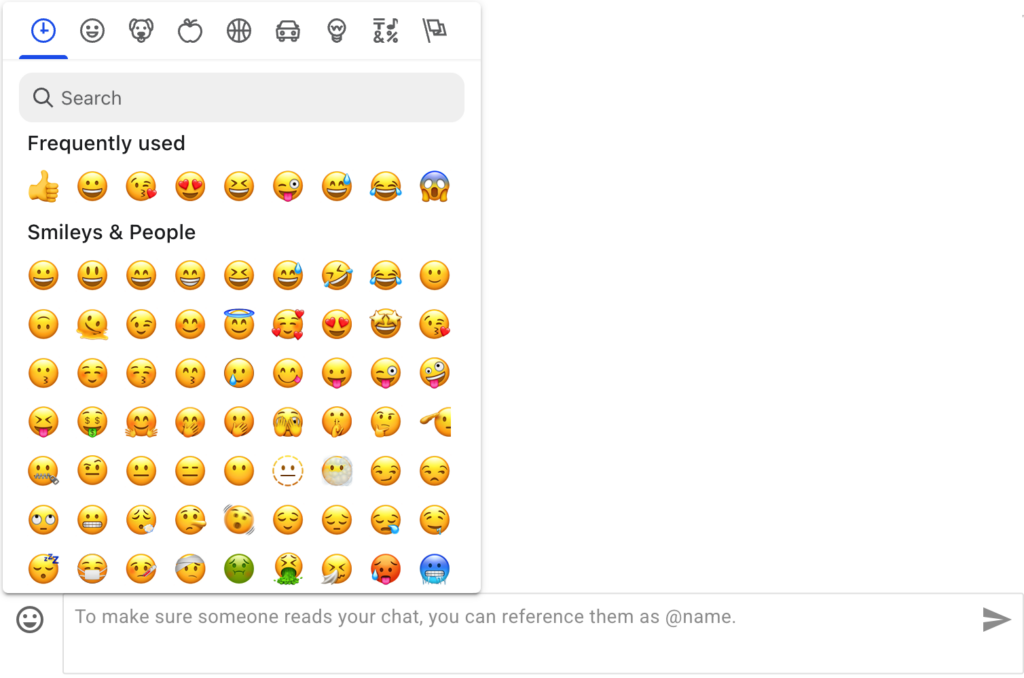
At the request of a user, we have added the ability for you to include emoji in your chat:

As folks use Kerika over a long time, and for a variety of purposes, they may end up with dozens or more Task Boards and Whiteboards in their account.
One easy way to keep your focus on the most important boards is to use the Favorites feature: the Home screen has separate tabs for Favorites and All Others:
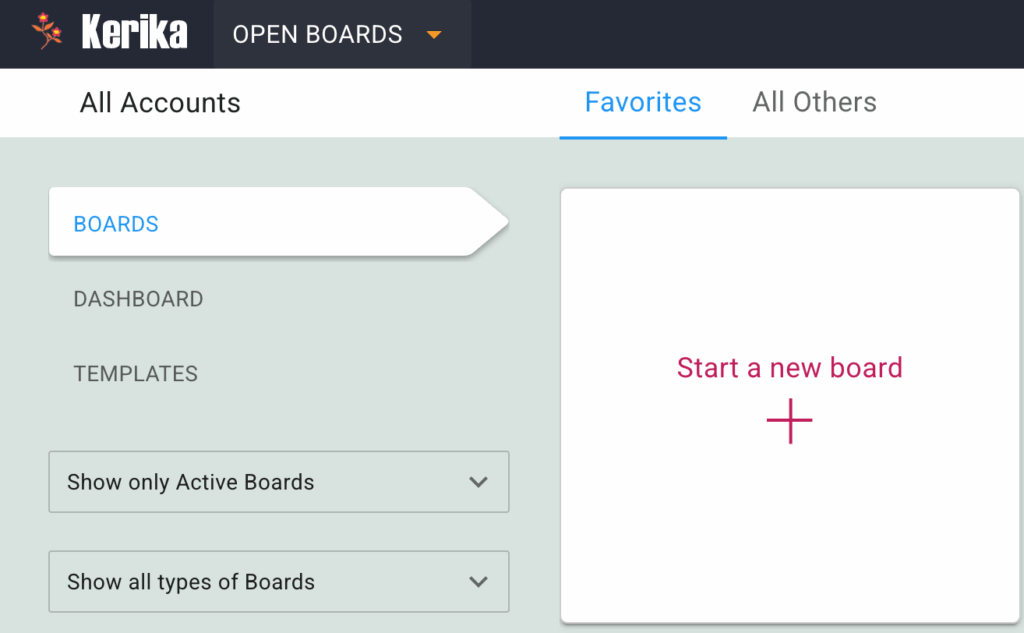
We have made it even easier with two new filters:
Enjoy.
We have implemented a “cookie consent” pop-up dialog that appears to folks when they visit the kerika.com website:

There’s an option to manage which cookies you accept:
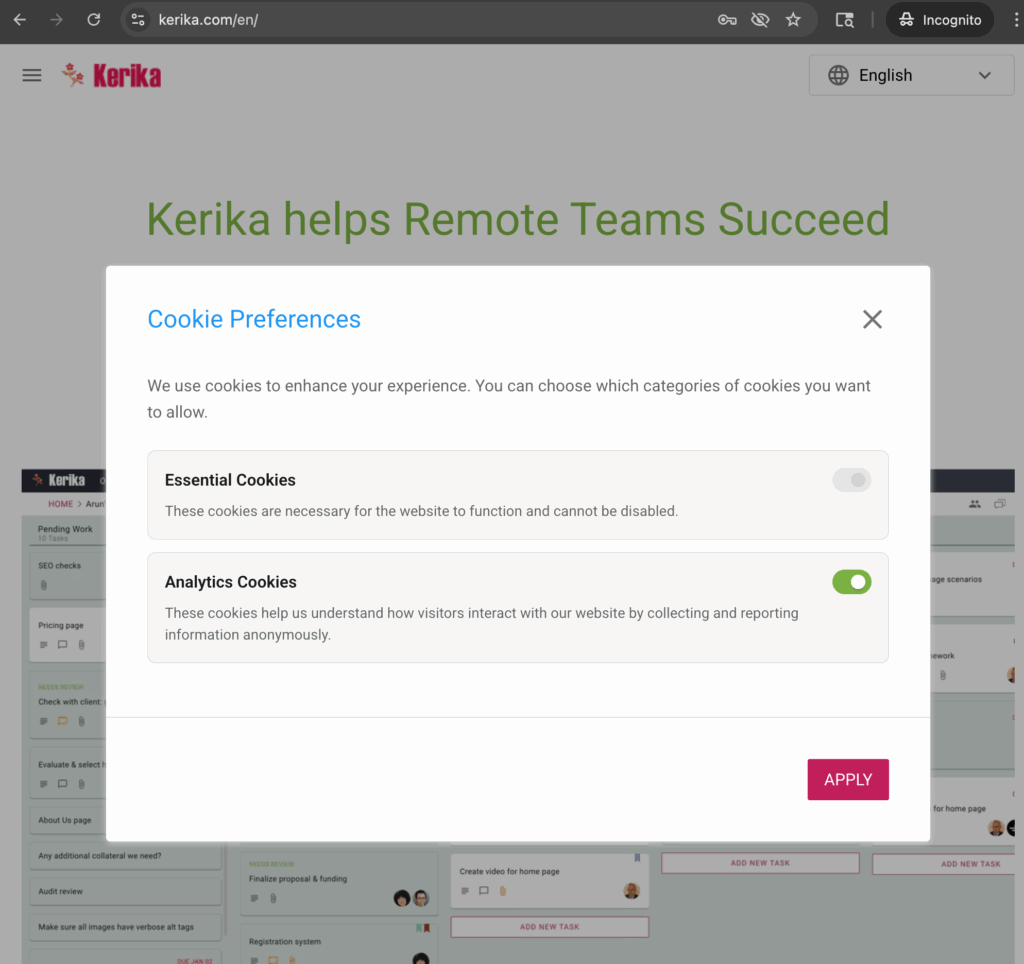
The ability to hide (collapse) columns is very useful when a board has many columns, and not all of them are immediately important. We have now made it easier to use hidden columns: if you want to drag-and-drop a task into a hidden column, just hold it over the hidden column for a couple of seconds and the column will open to let you drop the task into it.
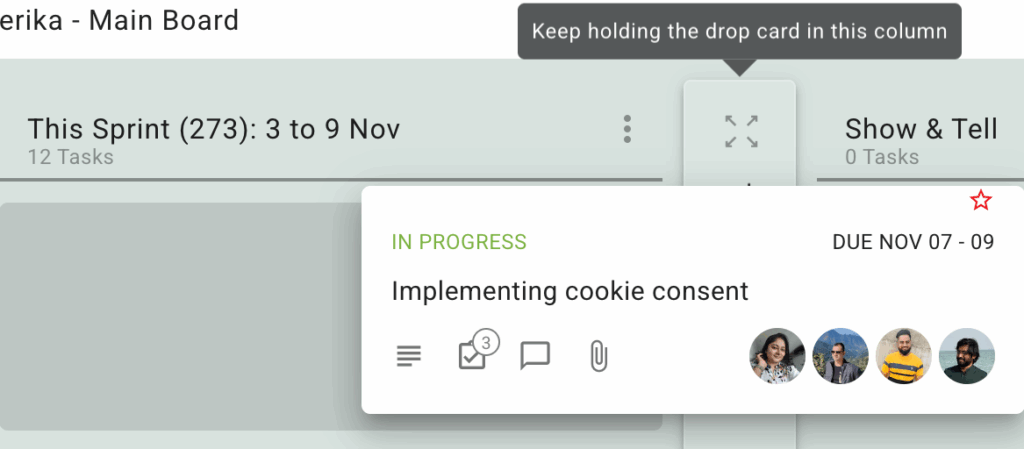
Did you know that you can easily rearrange the columns on a Task Board by pressing down on the column name for a couple of seconds? This makes the column “draggable” which means you can then move it easily to the right or left to change its position within the board.
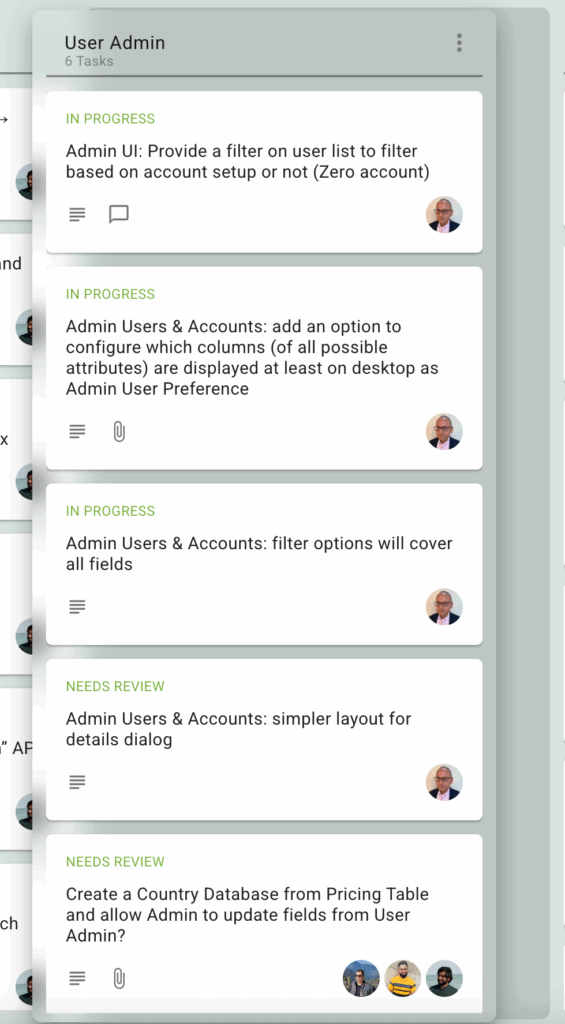
Sometimes you want to mark an entire board as read, for example when you don’t have the time to catch up on all the changes that took place (and maybe you don’t care?)
There’s an easy way to do this now: from your Home screen in the Kerika app, right-click on any board card and you will find a new “Mark all tasks as read” option in the dialog that pops-up:
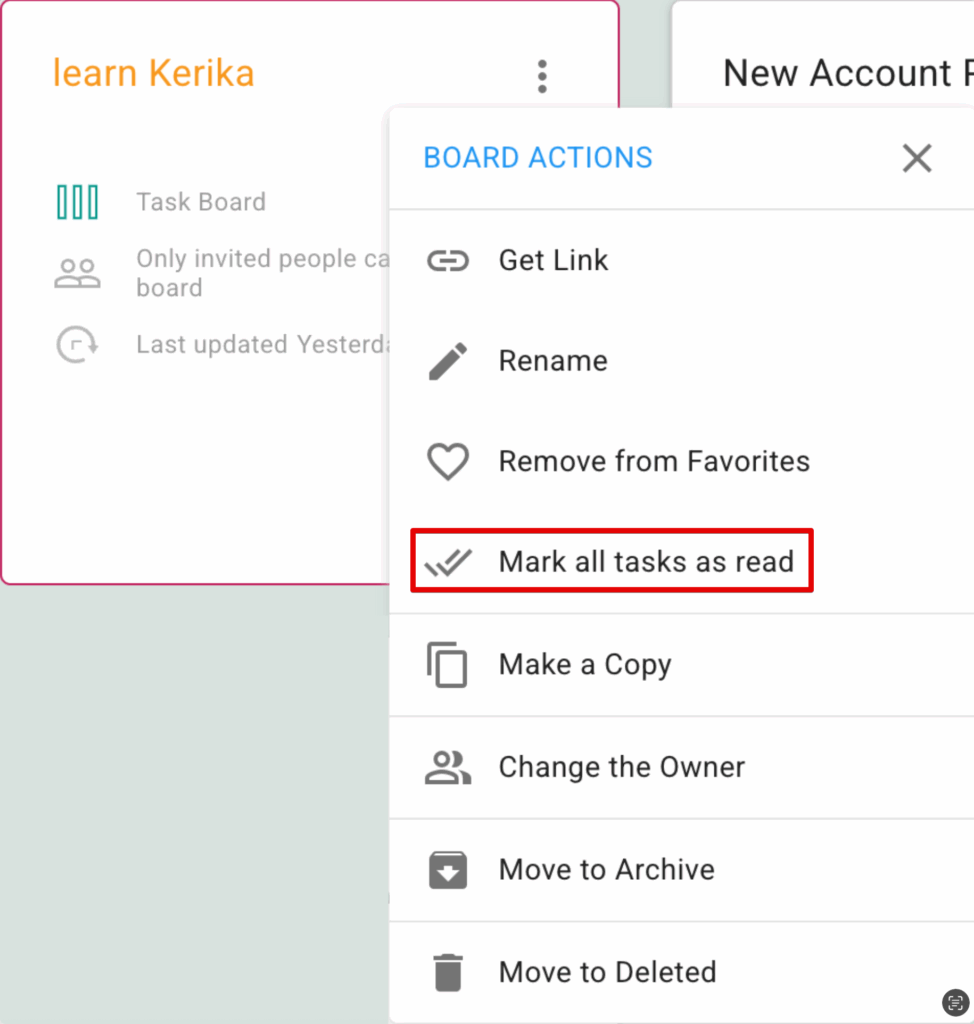
Harga lama kami tidak berubah selama lebih dari 10 tahun, dan tidak lagi mencerminkan nilai produk kami, mahupun hakikat bahawa kini kami mempunyai lebih ramai pengguna di luar Amerika Syarikat berbanding di dalam.
Oleh itu, sudah tiba masanya untuk kami mengemas kini model harga kami secara menyeluruh! Dalam catatan blog ini, kami akan merangkum semua perubahan, dan dalam bahagian di bawah, anda akan menemui pautan ke catatan blog dan halaman laman web lain yang membincangkan setiap perkara dengan lebih terperinci:
Selama 10 tahun yang lalu, kami hanya mempunyai satu harga: $7 bagi setiap Ahli Pasukan Akaun, dibayar setiap tahun. Walaupun harga ini agak rendah bagi pasaran Amerika Syarikat, ia menjadi cabaran bagi pengguna dari negara dengan ekonomi yang kurang berkembang dan kuasa beli yang lebih rendah.
Kami kini menjadikan Kerika lebih berpatutan bagi pengguna di luar Amerika Syarikat: harga baharu untuk Pelan Profesional bagi pelanggan di AS adalah $9 setiap pengguna sebulan, atau $90 setiap tahun, tetapi pelanggan dari hampir semua negara lain boleh melanggan pada kadar yang lebih rendah. Ini bermakna pelanggan dari negara dengan ekonomi yang lebih kecil boleh membeli langganan Kerika yang sama seperti pelanggan dari negara yang lebih kaya, tetapi dengan harga yang jauh lebih murah.
Perubahan ini akan dapat dilihat apabila anda mengunjungi halaman harga di laman web Kerika, serta dalam aplikasi Kerika. Harga yang dipaparkan akan merupakan jumlah selepas diskaun, dan ia akan dipaparkan dalam mata wang tempatan anda. Sebagai contoh, pengguna dari Malaysia akan melihat Pelan Profesional berharga RM 20 sebulan / RM 200 setahun.
(Pelan Perniagaan untuk pelanggan di Korea Selatan akan berharga RM 30 sebulan / RM 300 setahun.)
Selain harga yang lebih rendah di luar Amerika Syarikat, kami juga membolehkan pelanggan kami membayar dalam pelbagai mata wang — sebanyak 135 mata wang semuanya.
Ini akan memudahkan orang di negara yang berbeza, yang mungkin menghadapi kesukaran untuk membuat pembelian dalam Dolar AS, untuk membeli langganan Kerika.
Baca lebih lanjut mengenai mata wang.
Pengguna yang baru dalam mana-mana perkhidmatan dalam talian mungkin ragu-ragu untuk membeli langganan tahunan sebelum mereka benar-benar biasa dengan perkhidmatan tersebut. Pilihan semula jadi bagi pelanggan baharu ialah membuat komitmen kewangan yang lebih kecil pada awalnya, dengan membeli langganan bulanan. Kami telah memudahkan perkara ini.
Kini, anda boleh membeli Langganan Bulanan atau Tahunan (tetapi tidak boleh mencampurkan kedua-duanya).
Langganan tahunan berharga 10 kali ganda kadar bulanan, jadi jika anda bercadang untuk menggunakan Kerika lebih daripada 10 bulan, adalah lebih jimat untuk mendapatkan langganan tahunan.
Namun, jika anda pelanggan baharu dan masih ragu-ragu untuk membuat komitmen kepada Kerika, kini anda mempunyai cara yang lebih mudah untuk terus menggunakan Kerika selepas Percubaan Percuma 30 hari anda tamat: hanya beli langganan bulanan untuk beberapa bulan, dan kemudian beralih kepada langganan tahunan untuk penjimatan kos setelah anda yakin dengan manfaat Kerika bagi produktiviti pasukan anda.
Dan untuk memudahkan lagi pelanggan baharu membeli Langganan Tahunan dengan yakin, kami kini menawarkan Jaminan Wang Dikembalikan 30 Hari yang sangat mudah!
Jika anda menukar fikiran dalam masa 30 hari selepas membeli Langganan Tahunan, atas sebarang sebab, anda boleh meminta bayaran balik penuh dalam bentuk tunai.
Kini anda tidak perlu risau sama ada anda membuat keputusan yang salah apabila mengklik butang Beli!
Baca lebih lanjut mengenai Jaminan Wang Dikembalikan 30 Hari kami.
Sistem lama kami untuk mengira dan menguruskan bayaran balik adalah sangat rumit: ia mencipta kesulitan dalam sistem bil kami, dan kesulitan itu seterusnya menyebabkan pelbagai masalah yang menjejaskan pelanggan dan kami sendiri.
Kami kini beralih kepada sistem yang lebih mudah: jika anda membatalkan langganan, anda akan menerima kredit pro rata dalam akaun Kerika anda, yang boleh digunakan untuk pembelian pada masa hadapan. Kredit ini tidak akan luput dan tidak boleh ditebus dalam bentuk tunai: ia hanya boleh digunakan untuk pembelian akan datang.
Baca lebih lanjut mengenai Dasar Bayaran Balik kami.
Pelan Akademik & Badan Bukan Keuntungan yang lama membenarkan Pasukan Akaun sehingga 10 orang menggunakan Kerika secara percuma. Walau bagaimanapun, ia sukar untuk dikendalikan, sering disalahgunakan, dan tidak dapat membantu semua sekolah, universiti, dan organisasi bukan keuntungan.
Pelan Akademik & Badan Bukan Keuntungan kini akan berfungsi sebagai diskaun mudah sebanyak 50%: jika anda layak, anda boleh membeli mana-mana pelan pada separuh harga, dan tidak akan ada lagi had bagi saiz Pasukan Akaun anda. Pelan baharu ini memudahkan organisasi yang lebih besar untuk menggunakan Kerika di seluruh organisasi mereka.
Baca lebih lanjut mengenai Diskaun Badan Bukan Keuntungan.
Kami sebelum ini menawarkan pilihan untuk meminta invois yang boleh dibayar menggunakan cek bank atau pemindahan terus, tetapi malangnya, pilihan ini sering disalahgunakan oleh sebilangan pengguna yang meminta invois tetapi tidak membayarnya, serta mengabaikan e-mel peringatan kami!
Dengan sistem baharu kami, pilihan untuk membuat pembelian luar talian (iaitu, meminta invois) hanya tersedia kepada pelanggan tertentu. Beberapa pelanggan lama kami telah menggunakan kaedah luar talian selama bertahun-tahun kerana itu satu-satunya cara mereka boleh membuat pembelian — situasi biasa bagi mereka yang bekerja dalam sektor kerajaan atau syarikat besar yang memerlukan invois diproses melalui jabatan Akaun Belum Bayar mereka.
Bagi pelanggan lama ini, kaedah luar talian akan terus tersedia, tetapi akan dikuatkuasakan dengan lebih ketat: jika invois tidak dibayar tepat pada masanya, langganan yang berkaitan akan dibatalkan.
Jika anda pelanggan baharu yang memerlukan kaedah luar talian, sila hubungi kami!
Dengan sistem harga baharu, pelanggan kami kini boleh menggantikan satu pengguna dengan pengguna lain tanpa dikenakan caj tambahan, selagi penyingkiran pengguna lama dan penambahan pengguna baharu dilakukan pada hari yang sama.
Jika seorang pengguna dikeluarkan daripada Pasukan Akaun dan pengguna lain ditambah pada hari yang sama, sistem tidak akan menjana sebarang transaksi bil.
Skrin Sejarah Bil, yang boleh diakses dengan mengklik pilihan Urus Akaun dalam menu yang muncul apabila anda mengklik avatar anda di bahagian atas kanan aplikasi desktop, kini akan mengandungi lebih banyak maklumat mengenai perubahan yang dibuat, seperti menghidupkan/mematikan auto-pembaharuan, menambah pengguna, dan sebagainya.
Ini akan membantu pelanggan memahami dengan lebih baik bagaimana bil mereka berubah dari semasa ke semasa.
Peralihan yang Lancar
Jika anda sudah menjadi pelanggan Kerika, pelan anda akan diteruskan seperti biasa sehingga tamat tempohnya.
Kami faham bahawa perubahan harga boleh menyebabkan kebimbangan bagi sesetengah pengguna. Kami sedia membantu menjawab pertanyaan anda dan mendengar maklum balas anda. Hubungi kami!
Ang lumang sistema ng pagpepresyo namin ay hindi nagbago sa loob ng mahigit 10 taon, at hindi na ito sumasalamin sa tunay na halaga ng aming produkto — lalo na ngayon na mas marami na kaming mga gumagamit mula sa labas ng Estados Unidos kaysa sa loob nito.
Kaya’t panahon na upang i-update namin ang aming modelo ng pagpepresyo sa lahat ng aspeto! Sa blog post na ito, buod ang lahat ng mga pagbabago, at sa mga seksyon sa ibaba ay makikita mo ang mga link patungo sa iba pang blog posts at mga pahina ng aming website na tatalakay ng bawat detalye:
Sa loob ng nakaraang 10 taon, iisa lang ang presyo: $7 bawat miyembro ng Account Team, binabayaran taun-taon. Bagama’t mababa ito para sa merkado ng US, naging hadlang ito para sa mga bansa na may hindi gaanong maunlad na ekonomiya at mababang purchasing power.
Ginagawa naming mas abot-kaya ang Kerika para sa mga gumagamit sa labas ng Estados Unidos: habang ang bagong presyo ng Professional Plan para sa US-based na customers ay $9 kada buwan o $90 taun-taon, makakabili ang mga customer mula sa halos lahat ng ibang bansa ng subscription sa mas mababang halaga.
Makikita ito kapag binisita mo ang Pricing Page ng Kerika o tiningnan mo ang mga available na plano sa loob ng app. Ipapakita ang presyo sa lokal mong pera. Halimbawa, para sa mga gumagamit sa Pilipinas, makikita nila ang Professional Plan sa halagang ₱200 / buwan o ₱2,000 taun-taon.
(Para naman sa Business Plan, ang presyo ay ₱300 / buwan o ₱3,000 taun-taon.)
Kasabay ng mas murang presyo sa labas ng US, pinapagana na rin namin ang pagbabayad gamit ang 135 na iba’t ibang uri ng pera.
Mas madali na ngayon para sa mga nasa ibang bansa na hindi makabili gamit ang US Dollars ang mag-subscribe sa Kerika.
👉 Basahin pa tungkol sa mga sinusuportahang currency.
Maaaring magdalawang-isip ang mga bagong user na agad bumili ng taunang subscription kung hindi pa sila pamilyar sa serbisyo. Mas natural na magsimula muna sa mas maliit na commitment gamit ang buwanang subscription — at pinapadali na namin ito ngayon!
Pwede ka nang pumili sa pagitan ng buwanan o taunan (hindi pinaghalong dalawa).
Ang taunang subscription ay 10x ng buwanang presyo, kaya kung balak mong gamitin ang Kerika nang higit sa 10 buwan, mas makakatipid ka kung taunang plano ang pipiliin.
Pero kung bago ka pa lang sa Kerika at hindi pa sigurado, madali ka nang makakapagpatuloy pagkatapos ng 30-araw na Libreng Pagsubok: magsimula sa buwanang subscription, tapos lumipat sa taunang plano kapag kumbinsido ka na sa mga benepisyo ng Kerika para sa produktibidad ng iyong team.
Para mas mapagaan ang loob ng mga bagong user, nag-aalok na kami ngayon ng napakasimpleng 30-araw na Money Back Guarantee!
Kung magbago ang isip mo sa loob ng 30 araw matapos bumili ng taunang subscription, kahit anong dahilan, pwede kang humiling ng buong refund.
Wala nang alalahanin kung tama ba ang pagbili mo — subukan mo lang!
👉 Basahin pa ang tungkol sa aming 30-araw na Money Back Guarantee.
Ang dati naming refund system ay napakakumplikado: naging sanhi ito ng bugs at problema sa billing.
Ngayon, mas simple na: kapag nag-cancel ka ng subscription, makakakuha ka ng pro-rata na credit sa iyong Kerika account para sa mga susunod na pagbili. Ang credits ay hindi mawawala at hindi maaaring i-convert sa cash — para lang ito sa future purchases.
👉 Basahin pa ang tungkol sa aming Refund Policy.
Dati, pinapayagan namin ang Account Teams ng hanggang 10 katao na gumamit ng Kerika nang libre, pero mahirap itong i-manage at madalas ay naaabuso.
Ngayon, ang bagong plano ay isang diretsong 50% na diskwento: kung kwalipikado ka, maaari mong bilhin ang anumang plano sa kalahating presyo, kahit gaano kalaki ang iyong team. Mas madali na para sa buong paaralan o organisasyon na gumamit ng Kerika.
👉 Basahin pa ang tungkol sa Nonprofit Discount.
Dati, pwede kang humiling ng invoice at magbayad sa pamamagitan ng bank cheque o direct deposit. Ngunit maraming user ang nagsamantala sa opsyong ito — humihiling ng invoice pero hindi nagbabayad.
Ngayon, ang offline na pagbili (i.e. invoice request) ay para na lang sa piling customer, lalo na yung mga matagal nang gumagamit ng offline method (hal. gobyerno o malalaking kumpanya).
Para sa kanila, mananatili ito pero ipapatupad nang mahigpit: kapag hindi bayad ang invoice sa takdang panahon, ika-cancel ang subscription.
Kung bago ka at kailangan mong gumamit ng offline method, 👉 makipag-ugnayan sa amin.
Sa bagong pricing system, madali mo nang mapalitan ang isang user ng isa pa nang walang dagdag na bayad, basta sa parehong araw ito ginawa.
Kung ang isang user ay inalis at pinalitan sa parehong araw, walang mabubuong bagong singil.
Sa Billing History screen (makikita sa Manage Account mula sa menu sa kanang itaas), makikita mo na ngayon ang mas detalyadong impormasyon tulad ng pagbabago sa auto-renewal, pagdagdag ng user, atbp.
Mas malinaw mo nang mauunawaan kung paano nagbabago ang billing mo sa paglipas ng panahon.
Ito ang pinakamahalaga: kung kasalukuyan kang customer ng Kerika, mananatili ang iyong kasalukuyang plano hanggang sa matapos ang term nito.
Kung binili mo noon sa $84/user at ang bagong presyo sa iyong rehiyon ay ₱2,400, hindi ka kailangang magbayad muli ngayon — sa susunod mong renewal pa ito magiging epektibo.
Ganoon din para sa lumang Academic & Nonprofit Plan — itutuloy ito hanggang matapos ang term, at pagkatapos ay pwede kang lumipat sa bagong Professional o Business Plan na may automatic Nonprofit Discount.
Alam naming ang mga pagbabago sa presyo ay maaaring makaapekto sa ilan, kahit gaano pa ito pinag-isipan. Masaya kaming sagutin ang iyong mga tanong at pakinggan ang iyong mga saloobin.
Giá cũ của chúng tôi đã không thay đổi trong hơn 10 năm và không còn phản ánh đúng giá trị của sản phẩm, cũng như thực tế rằng hiện tại chúng tôi có nhiều người dùng ngoài Hoa Kỳ hơn là trong nước.
Vì vậy, đã đến lúc chúng tôi cập nhật mô hình định giá của mình một cách toàn diện! Trong bài viết này, chúng tôi sẽ tóm tắt tất cả các thay đổi, và ở các phần bên dưới bạn sẽ tìm thấy liên kết đến các bài blog khác và các trang trên website trình bày chi tiết hơn từng nội dung:
Trong 10 năm qua, chúng tôi chỉ có một mức giá: $7 cho mỗi thành viên trong nhóm tài khoản, thanh toán hàng năm. Mức giá này tương đối thấp so với thị trường Hoa Kỳ, nhưng lại gây khó khăn cho người dùng ở các quốc gia có nền kinh tế kém phát triển và sức mua thấp hơn.
Chúng tôi đang làm cho Kerika trở nên phải chăng hơn cho người dùng ngoài Hoa Kỳ: trong khi mức giá mới cho Gói Chuyên Nghiệp cho khách hàng ở Hoa Kỳ là $9 mỗi người mỗi tháng, hoặc $90 mỗi năm, thì khách hàng từ gần như mọi quốc gia khác đều có thể mua với mức giá thấp hơn. Điều này có nghĩa là người dùng ở các nền kinh tế nhỏ có thể đăng ký Kerika với mức giá ưu đãi hơn rất nhiều so với các nước giàu.
Bạn sẽ thấy điều này khi truy cập trang định giá của website Kerika hoặc khi xem các gói trong ứng dụng Kerika. Mức giá hiển thị sẽ là mức giá đã giảm, và sẽ hiển thị bằng đơn vị tiền tệ địa phương của bạn. Ví dụ, người dùng tại Việt Nam sẽ thấy Gói Chuyên Nghiệp có giá ₫13.400 mỗi tháng / ₫134.000 mỗi năm.
(Gói Doanh Nghiệp dành cho khách hàng Việt Nam sẽ có giá ₫194.200 mỗi tháng / ₫1.942.000 mỗi năm.)
Bên cạnh mức giá thấp hơn, chúng tôi còn cho phép khách hàng thanh toán bằng nhiều loại tiền tệ khác nhau — tổng cộng là 135 loại tiền.
Điều này giúp người dùng ở nhiều quốc gia dễ dàng hơn trong việc thanh toán, đặc biệt nếu họ gặp khó khăn khi thanh toán bằng Đô la Mỹ.
Tìm hiểu thêm về các loại tiền tệ được hỗ trợ.
Người dùng mới thường do dự khi đăng ký gói theo năm trước khi hiểu rõ dịch vụ. Họ có xu hướng chọn các gói thanh toán theo tháng để giảm rủi ro về tài chính. Chúng tôi giúp bạn dễ dàng làm điều này.
Giờ đây bạn có thể chọn mua gói theo tháng hoặc theo năm (không thể kết hợp cả hai).
Gói theo năm sẽ có giá bằng 10 lần gói theo tháng. Vì vậy, nếu bạn có kế hoạch sử dụng Kerika hơn 10 tháng thì mua gói năm sẽ tiết kiệm hơn.
Nhưng nếu bạn là người dùng mới và còn phân vân, bạn hoàn toàn có thể tiếp tục dùng Kerika sau khi hết thời gian Dùng Thử Miễn Phí 30 ngày bằng cách đăng ký thuê bao theo tháng trong vài tháng đầu, sau đó chuyển sang gói năm để tiết kiệm chi phí.
Để giúp người dùng mới yên tâm hơn khi mua gói năm, chúng tôi hiện đang cung cấp Chính sách Hoàn Tiền 30 Ngày rất đơn giản!
Nếu bạn đổi ý trong vòng 30 ngày kể từ ngày mua gói thuê bao năm, vì bất kỳ lý do gì, bạn có thể yêu cầu hoàn lại toàn bộ số tiền đã thanh toán.
Bạn không còn phải lo lắng mình có mắc sai lầm khi bấm nút Mua hay không nữa!
Tìm hiểu thêm về Chính sách Hoàn Tiền 30 Ngày của chúng tôi.
Hệ thống hoàn tiền cũ của chúng tôi thực sự là một nỗi đau: nó khiến hệ thống thanh toán trở nên phức tạp và gây ra nhiều lỗi ảnh hưởng đến cả khách hàng và chúng tôi.
Giờ đây, chúng tôi áp dụng hệ thống đơn giản hơn: nếu bạn hủy gói thuê bao, bạn sẽ được cấp tín dụng theo tỷ lệ trong tài khoản Kerika của mình để dùng cho các giao dịch sau này. Tín dụng này không có thời hạn sử dụng và không thể đổi thành tiền mặt — chỉ có thể dùng để mua hàng trong tương lai.
Xem thêm về Chính sách Hoàn Tiền của chúng tôi.
Trước đây, gói dành cho học thuật & tổ chức phi lợi nhuận cho phép các nhóm lên đến 10 người sử dụng Kerika miễn phí. Tuy nhiên, điều này khó quản lý, dễ bị lạm dụng và không giúp ích cho mọi trường học hay tổ chức.
Giờ đây, chương trình này sẽ được chuyển thành giảm giá 50% đơn giản: nếu bạn đủ điều kiện, bạn có thể mua bất kỳ gói nào với giá chỉ bằng một nửa. Không còn giới hạn số lượng thành viên trong nhóm tài khoản.
Tìm hiểu thêm về Giảm giá cho tổ chức phi lợi nhuận.
Trước đây chúng tôi cho phép yêu cầu hóa đơn để thanh toán bằng séc ngân hàng hoặc chuyển khoản, nhưng phương thức này đã bị nhiều người dùng lợi dụng — họ yêu cầu hóa đơn nhưng không thanh toán và cũng phớt lờ các email nhắc nhở!
Với hệ thống mới, phương thức thanh toán ngoại tuyến (tức là yêu cầu hóa đơn) chỉ áp dụng cho một số khách hàng đặc biệt. Một số khách hàng lâu năm đã dùng phương thức này trong nhiều năm do yêu cầu từ tổ chức (ví dụ như cơ quan chính phủ hoặc tập đoàn lớn yêu cầu xử lý qua phòng Kế Toán).
Đối với những khách hàng này, phương thức ngoại tuyến vẫn được duy trì, nhưng sẽ bị giám sát chặt chẽ: nếu hóa đơn không được thanh toán đúng hạn, thuê bao sẽ bị hủy.
Nếu bạn là khách hàng mới cần dùng phương thức ngoại tuyến, hãy liên hệ với chúng tôi!
Với hệ thống giá mới, khách hàng có thể thay thế một người dùng bằng người khác trong cùng một ngày mà không phát sinh thêm chi phí, miễn là việc thay thế diễn ra trong cùng ngày.
Nếu một người dùng bị xóa khỏi nhóm và một người khác được thêm vào trong cùng một ngày, hệ thống sẽ không tạo ra giao dịch thanh toán nào.
Màn hình Lịch Sử Thanh Toán (Billing History), có thể truy cập bằng cách nhấp vào Quản lý Tài Khoản trong menu khi bạn bấm vào ảnh đại diện ở góc phải trên cùng của ứng dụng máy tính để bàn, giờ đây sẽ hiển thị nhiều thông tin hơn về các thay đổi như bật/tắt tự động gia hạn, thêm người dùng, v.v.
Điều này sẽ giúp bạn hiểu rõ hơn về quá trình thanh toán của mình theo thời gian.
Đây có lẽ là phần quan trọng nhất: nếu bạn đã là khách hàng của Kerika với bất kỳ gói nào, gói hiện tại sẽ tiếp tục có hiệu lực cho đến khi hết thời hạn.
Nếu bạn đã mua với giá $84/người mỗi năm, và giá hiện tại cho khu vực của bạn là ₫134.000 mỗi năm, bạn không cần thanh toán thêm gì ngay bây giờ. Khi hết hạn, mức giá mới sẽ được áp dụng.
Tương tự, nếu bạn đang sử dụng gói học thuật & phi lợi nhuận cũ, gói này sẽ tiếp tục cho đến khi hết thời hạn. Khi đó bạn sẽ cần mua Gói Chuyên Nghiệp hoặc Gói Doanh Nghiệp, nhưng bạn sẽ tự động đủ điều kiện nhận Giảm Giá Phi Lợi Nhuận.
Chúng tôi hiểu rằng việc thay đổi giá cả có thể khiến một số người dùng lo lắng, dù chúng tôi đã nỗ lực thiết kế mô hình mới một cách cẩn thận. Chúng tôi rất sẵn lòng giải đáp mọi thắc mắc và lắng nghe ý kiến của bạn.
Liên hệ với chúng tôi!
Ruang kerja anda sepatutnya berfungsi untuk anda, bukan sebaliknya. Pilihan penyesuaian membolehkan anda menyesuaikan segala-galanya daripada warna latar belakang kepada pemberitahuan dan alatan papan putih, membantu anda kekal teratur dan produktif.
Untuk mula memperibadikan ruang kerja anda, anda perlu mengakses Tetapan Keutamaan dalam akaun anda. Begini caranya:
Tetapan ini membolehkan anda mencipta pengalaman yang sesuai dengan gaya kerja unik anda. Sekarang setelah anda tahu cara mengakses tetapan, izinkan kami membimbing anda langkah demi langkah bagaimana anda boleh menggunakan setiap pilihan penyesuaian.
Keutamaan biasanya dikumpulkan kepada tiga kategori utama: Umum, Pemberitahuan, dan Papan putih. Setiap bahagian menyediakan pilihan mudah yang direka untuk meningkatkan aliran kerja anda dan mengoptimumkan pengalaman anda.
Berikut ialah pandangan yang lebih dekat tentang cara tetapan ini berfungsi:
Faedahnya:
Menyesuaikan aspek visual ruang kerja anda menjadikannya lebih intuitif dan kurang bersepah, membantu anda kekal fokus.
Faedahnya:
Dengan pemberitahuan yang fleksibel, anda boleh terus mendapat maklumat tentang perkara yang paling penting tanpa dihujani dengan kemas kini yang tidak perlu.
Tetapan ini menjadikan papan putih sesuai untuk sumbang saran, merancang atau mereka bentuk, memastikan kerja anda kelihatan hebat dan kekal teratur.
Sama ada melaraskan elemen visual, menyesuaikan pemberitahuan atau memperkemas alatan kreatif, pilihan ini direka bentuk untuk meningkatkan produktiviti anda dan memastikan persekitaran kerja anda teratur. Mengambil sedikit masa untuk memperibadikan tetapan anda boleh membawa kepada pengalaman yang lebih cekap dan menyeronokkan setiap hari.